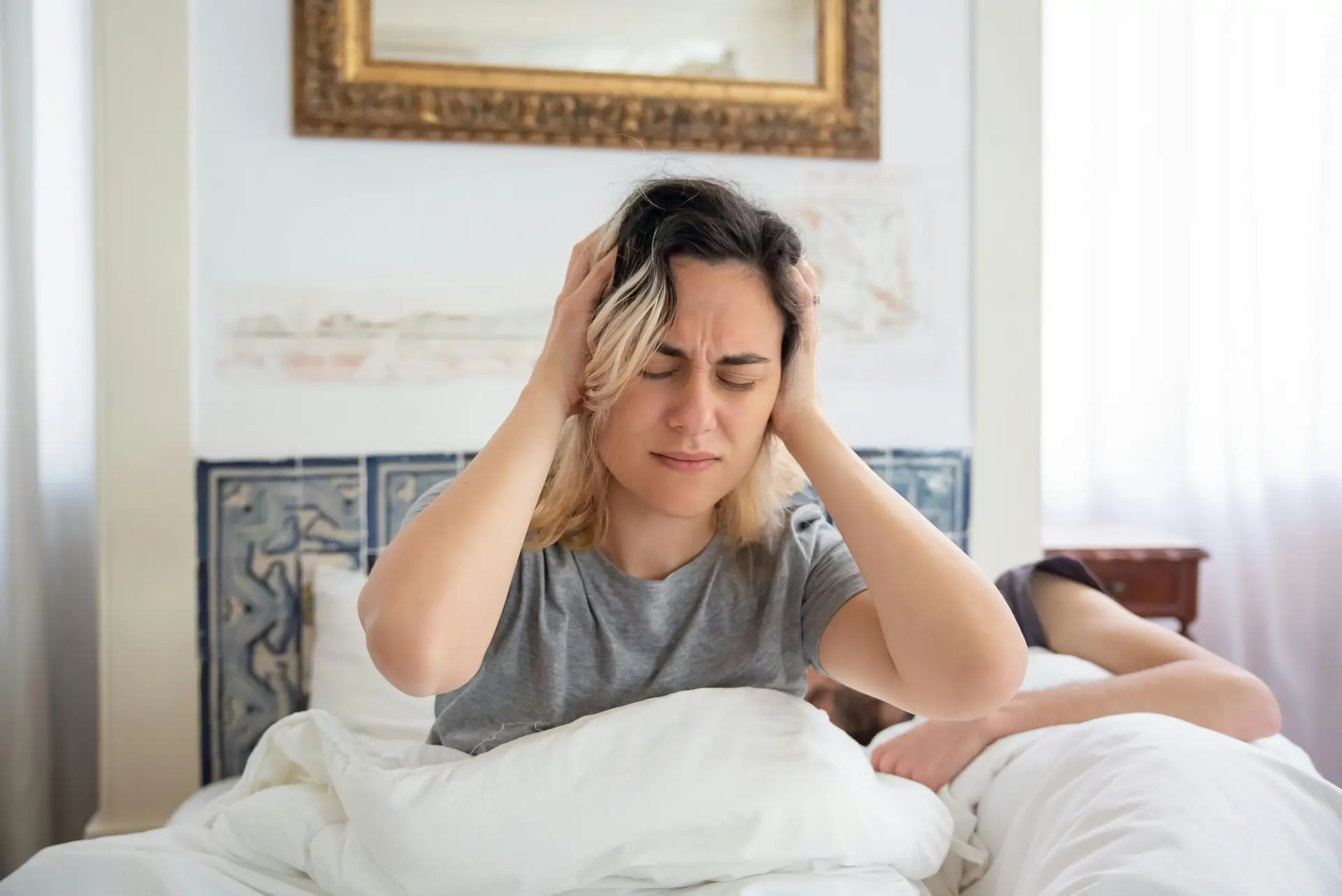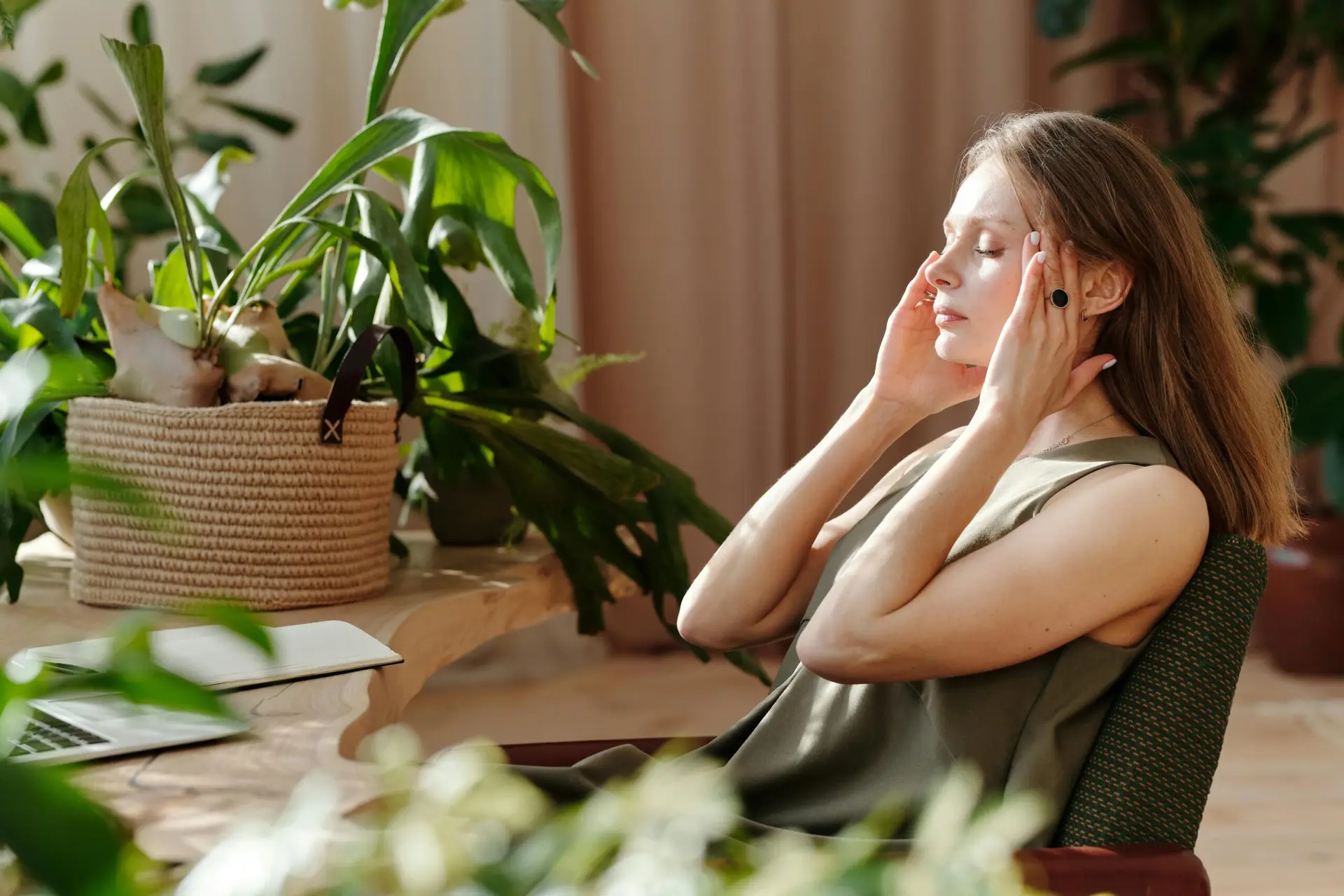
What Causes Head Pressure? Head pressure can feel like a slow-building storm inside your skull: a tight band across your forehead, fullness behind the eyes, a ballooning sensation in the temples, or a heavy fog that turns clear thinking into a chore. For some, it’s a daily nuisance. For others, it’s life-altering—especially when it rides alongside migraines, tension headaches, POTS (Postural Orthostatic Tachycardia Syndrome), or Idiopathic Intracranial Hypertension (IIH).
If you’ve tried pills, hydration hacks, magnesium, or even sinus sprays and you’re still wondering, “What is actually causing all this pressure?” you’re in the right place. At Lavender Family Chiropractic—your upper cervical chiropractor near me in Sarasota, Florida—we focus on the root cause so you can experience relief that lasts. Our team (Dr. Rusty Lavender, Dr. Jacob Temple, and Dr. Will Guzinski) specializes in Upper Cervical Chiropractic, using 3D CBCT imaging and functional nervous system scans (Tytron infrared thermography) to detect subtle misalignments at the top of the spine that can influence blood flow, cerebrospinal fluid (CSF) dynamics, and brainstem regulation.
This comprehensive guide explains how the upper cervical spine—particularly the atlas (C1) and axis (C2)—can be the hidden driver behind head pressure sensations. We’ll discuss how IIH, migraines, pressure headaches, tension headaches, and POTS may be connected to upper cervical imbalance and why a gentle, precise, non-twisting correction can unlock your body’s natural ability to heal.
What Causes Head Pressure? Why “Head Pressure” Is More Than Just a Headache
“Head pressure” isn’t a diagnosis; it’s a signal. That sense of fullness, heaviness, or internal squeeze can reflect changes in:
- Cerebrospinal fluid (CSF) movement
- Venous drainage from the head and neck
- Arterial flow to the brain
- Autonomic nervous system regulation (blood pressure, heart rate, vessel tone)
- Neuromuscular tension at the skull base and upper neck
The upper cervical spine sits at the crossroads of all five. When the atlas and axis shift even a few millimeters, they can subtly distort the head-neck relationship. That shift may:
- Create mechanical tension near the brainstem
- Influence CSF flow between skull and spine
- Alter venous outflow (how fluids leave the head)
- Change muscle tone in the suboccipital region
- Disrupt baroreceptor and autonomic feedback loops
The result? Many people feel pressure, fog, dizziness, and fatigue, often without “abnormal” findings on routine imaging. That’s why we take a different approach in Sarasota: measure precisely, correct gently, and verify objectively.
Upper Cervical 101: Your Body’s “Fuse Box” for Pressure and Balance
The brainstem—protected by C1 and C2—helps coordinate blood pressure, heart rate, balance, breathing, muscle tone, and pain modulation. Think of it as your body’s fuse box. If the wires at the top of the neck are kinked, circuits can flicker:
- Vessel tone can tighten or slacken at the wrong time
- CSF may not circulate efficiently
- Venous outflow can back up, producing a sense of fullness
- Suboccipital muscles can clamp down, spreading tension over the scalp
- Trigeminal pathways can amplify pain or pressure
Upper cervical misalignment isn’t always dramatic. It often stems from past events—car accidents (even low speed), sports impacts, falls, poor posture, dental or orthodontic changes, or cumulative micro-trauma. Over time, compensations become patterns. Patterns become symptoms. And symptoms become your “new normal.”
Our job is to break that pattern—without twisting, popping, or cracking.
How We Measure the Root Cause at Lavender Family Chiropractic
Precision matters. Before we touch your neck, we want to understand exactly what’s happening:
- 3D CBCT Imaging: Provides millimeter-level detail of the upper cervical joints. We can visualize the precise angle and direction of atlas/axis misalignment, anatomical variations, and the spatial relationships that 2D films or standard imaging may miss.
- Tytron Infrared Thermography: A noninvasive scan that measures paraspinal temperature asymmetries, an objective window into autonomic nervous system stress and inflammation patterns.
- Neurological & Postural Assessment: Functional checks to correlate your history (migraines, POTS, IIH-like symptoms, “pressure days”) with what we see on imaging and scans.
With this data, we design your unique correction vector. Our Knee-Chest Upper Cervical adjustments are gentle, precise, and specific—no twisting, cracking, or yanking. After correction, we re-scan to confirm that the nervous system is trending toward balance. Over follow-ups, we track stability, not just symptoms.
Idiopathic Intracranial Hypertension (IIH): The Pressure You Can’t Ignore
IIH—also called “pseudotumor cerebri”—involves elevated intracranial pressure without a space-occupying lesion. Common symptoms include:
- Diffuse head pressure or pain
- Pulsatile tinnitus (hearing your heartbeat in your ears)
- Visual changes (transient obscurations or blur)
- Neck stiffness, nausea, dizziness
- Worsening with Valsalva, straining, or certain postures
While IIH is labeled “idiopathic,” clinical experience suggests a meaningful craniocervical component in some patients. When the atlas isn’t seated properly, the geometry at the foramen magnum can change, potentially influencing:
- CSF outflow resistance
- Venous drainage through deep neck pathways
- Mechanical tension affecting brainstem and dural structures
At Lavender Family Chiropractic, we take a conservative, non-pharmacological, non-surgical path that focuses on restoring better structural balance and neurological ease. Many patients with head-pressure-dominant symptom sets report lighter head, quieter ears, clearer vision, and fewer pressure spikes as upper cervical balance improves. We coordinate care as needed and always encourage patients to maintain relationships with their primary and specialty providers.
Migraines: When Pressure, Light, and Sound Collide
Migraines are a neurological disorder with complex triggers—hormonal shifts, sleep disruption, foods, barometric change, stress. Yet triggers aren’t necessarily the root cause. The brainstem (especially the trigeminocervical complex) plays a central role in how the nervous system amplifies or dampens pain and pressure signals.
Upper cervical misalignment can irritate the trigeminal system and influence vascular tone. People often describe:
- One-sided pressure that becomes throbbing
- Eye pressure or sinus-like pain without infection
- Photophobia, phonophobia, nausea, “air hunger”
- Neck stiffness that precedes or follows the attack
By restoring head-neck alignment, we aim to reduce brainstem irritation, optimize venous outflow, and relieve suboccipital tension—a triple win for migraine frequency, intensity, and recovery time. Patients frequently report that their “migraine weather days” become less ominous and that post-drome fog shortens.
Pressure and Tension Headaches: The “Helmet” You Didn’t Ask For
Tension-type and pressure-dominant headaches feel like a helmet, band, or vise around the head. They’re often written off as “just stress,” but the full picture frequently includes:
- Suboccipital hypertonicity (tight muscles at skull base)
- Compensatory shoulder elevation and jaw clenching
- Venous congestion contributing to fullness
- Poor posture or prolonged screen time that feeds the cycle
When the atlas is out of balance, the small muscles that attach from C1/C2 to the skull work overtime to stabilize your head. That chronic tug can radiate through the scalp fascia and the greater occipital nerve distribution, producing soreness, pressure, and fatigue.
A precise upper cervical correction allows these muscles to let go. Patients often feel an immediate sense of “air in the head,” “lighter eyes,” and longer, easier breaths after care—signs that the body is sliding back toward parasympathetic ease.
POTS (Postural Orthostatic Tachycardia Syndrome): When Standing Turns the World Foggy
POTS involves an autonomic nervous system dysregulation. On standing, the body struggles to keep blood circulating efficiently to the brain, which can lead to:
- Head pressure, fullness, or “cotton-head”
- Lightheadedness, brain fog, fatigue
- Palpitations, anxiety sensations, temperature intolerance
- Exercise intolerance and prolonged recovery
Because the autonomic centers are closely tied to the brainstem, a misaligned atlas can act like “background noise” in the regulatory system. Patients with POTS frequently describe improvement in:
- Head pressure on standing
- Cognitive clarity and stamina
- Heart-rate swings and recovery after exertion
Upper cervical corrections are gentle, and we titrate care conservatively—respecting the sensitivity common in dysautonomia. Hydration, salt strategies, compression, and graded movement can all complement upper cervical work; we’re happy to collaborate with your broader care team.
But Is the Neck Really the Root of All These Issues?
Health is rarely single-cause. Nutrition, hormones, sleep, stress, past injuries, connective tissue integrity, and environmental factors all matter. What we see, day after day, is that upper cervical alignment often functions as a master regulator. When we correct it:
- Fluid dynamics (CSF and venous) tend to normalize
- Brainstem irritation quiets
- Autonomic tone re-balances
- Muscular guarding unwinds
- Symptoms move from loud and daily to quiet and occasional—and for many, gone
We don’t push a one-size-fits-all agenda. We measure, correct, re-measure, and adapt—your case is your case.
What Care Looks Like (Step by Step) at Lavender Family Chiropractic
- Discovery Consultation
We listen: your story, your timeline, your worst days, your goals. We clarify whether you’re dealing with IIH-like symptoms, migraines, pressure headaches, tension patterns, POTS—or a mix. - Objective Testing
- 3D CBCT to map C1/C2 and cranio-cervical anatomy
- Tytron thermography to assess autonomic stress patterns
- Postural and neurological checks to correlate function with findings
- Care Plan
We design a precise correction vector and a frequency plan that respects your system’s tolerance and lifestyle. Education is built in so you know what we’re measuring and why. - Gentle Upper Cervical Adjustment
Knee-Chest Upper Cervical—no twisting, popping, or cracking. The adjustment is quick, specific, and comfortable. - Post-Scan Confirmation
We re-scan to verify a favorable neurological shift. Your body’s response guides our cadence. - Stabilization & Retention
As symptoms quiet and scans stabilize, we space out visits. Our goal is lasting alignment, not constant adjusting.
Three Patient Stories (Names Changed, Results Realistic)
“Erin—The IIH-Like Pressure and Whooshing”
Erin had daily pressure behind the eyes, pulsatile tinnitus, and “balloon head” after long days. CBCT showed a distinct atlas tilt and rotation; thermography reflected persistent autonomic asymmetry. After a series of precise corrections and lifestyle coaching (sleep position, workstation tweaks), she reported quieter ears, lighter head, and no “pressure flare days” for weeks at a time.
“Luis—The Weather-Triggered Migraineur”
Every cold front meant a three-day migraine for Luis. His atlas misalignment was modest but consistent. Correcting it reduced the frequency and intensity of attacks; on “weather weeks,” he now experiences mild pressure rather than full migraines—and they resolve same day.
“Sara—POTS and the Afternoon Crash”
Standing triggered head pressure, brain fog, and tachycardia for Sara. With gentle, spaced corrections and hydration/gradual activity guidance, her standing tolerance expanded, head pressure faded, and she reclaimed afternoons she had lost for years.
(Results vary. These stories illustrate typical experiences when the upper cervical spine is a meaningful factor.)
Why Lavender Family Chiropractic?
- Upper Cervical Specialists: Focused expertise in the most influential region of the spine
- Advanced Diagnostics: 3D CBCT + Tytron thermography—we don’t guess
- Gentle, Precise Corrections: No twisting, cracking, or popping
- Doctor Team Approach: Dr. Rusty Lavender, Dr. Jacob Temple, Dr. Will Guzinski collaborate on complex cases
- Measurable Progress: We track neurological balance and structural stability—not just symptom diaries
- Community Trust: Patients travel from across Sarasota, Bradenton, Lakewood Ranch, Parrish, Ellenton, Venice, Osprey, Punta Gorda, St. Petersburg, Siesta Key, Longboat Key, Lido Key, and Myakka City
If you’re searching “chiropractor Sarasota Florida,” “upper cervical chiropractor near me,” “vertigo doctor near me,” or “migraine doctor near me,” we would be honored to be part of your healing story.
Frequently Asked Questions (Top 15)
1) What actually causes head pressure?
Head pressure often reflects fluid dynamic changes (CSF/venous), neuromuscular tension, and autonomic dysregulation. Upper cervical misalignment at C1/C2 can influence all three—so correcting it frequently reduces pressure sensations.
2) Can upper cervical care help with IIH?
Many people with IIH-like symptom patterns report improvement when craniocervical balance is restored. By optimizing head-neck alignment, we aim to support freer CSF flow and better venous outflow. We encourage continued co-management with your medical team.
3) How is upper cervical different from regular chiropractic?
Upper cervical focuses only on the atlas and axis using 3D imaging and gentle, specific corrections—no twisting or cracking. The goal is to restore neurological balance at the source.
4) Will this help my migraines?
For many migraine patients, yes. When brainstem pressure and venous congestion calm down, frequency, intensity, and duration often drop markedly.
5) What about tension or pressure headaches?
These commonly improve as suboccipital muscles relax and venous outflow normalizes following an atlas correction.
6) Is this safe if I have POTS?
Yes. Our adjustments are very gentle. Many POTS patients appreciate the autonomic support that comes with restoring craniocervical balance.
7) How soon will I feel better?
Some feel relief immediately; others experience progressive changes over several weeks as stability builds. Chronic cases often need time for the nervous system to reset and retain.
8) How many visits will I need?
It depends on your history, imaging, and response. We aim for fewer, more precise adjustments and longer periods of holding alignment.
9) Will you twist or crack my neck?
No. We use Knee-Chest Upper Cervical methods—no twisting, popping, or yanking.
10) What technologies do you use?
3D CBCT (for exact structural mapping) and Tytron infrared thermography (for autonomic patterns). We re-scan to confirm improvement.
11) I’ve had MRI/CT that “showed nothing.” Can this still help?
Yes. Standard imaging often doesn’t analyze functional alignment between the head and neck. CBCT and specific analysis help us see what others might miss.
12) Can upper cervical misalignment cause pressure behind the eyes and ears?
It can contribute. Patients frequently report reduced eye pressure, ear fullness, and pulsatile tinnitus after corrections, especially when venous outflow improves.
13) Do you take insurance?
Our office is out of network with insurance. Many of our patients receive a superbill to submit to their insurance for reimbursement based on their coverage. We offer many different payment options as well as finance options.
14) Do you treat kids or older adults?
Yes. Adjustments are age-appropriate and gentle. We care for kids, athletes, busy parents, and seniors.
15) How do I get started?
Call (941) 243-3729 or visit www.chiropractorsarasotaflorida.com to schedule your consultation. We’ll review your case, perform scans, and discuss a precise plan.
Lifestyle Support That Enhances Upper Cervical Results
Sleep Position: Use a supportive pillow that keeps your neck neutral. Side or back sleeping typically works best; avoid stomach sleeping, which torques the neck.
Workstation Ergonomics: Raise your screen to eye level, keep elbows at 90°, and use a chair that supports your mid-back. Micro-breaks every 30–45 minutes relieve suboccipital strain.
Hydration & Electrolytes: Especially if you experience POTS-like symptoms. Adequate fluids support blood volume and pressure regulation.
Gentle Movement: Walking, breath work, or light mobility sessions can help your nervous system maintain the post-adjustment balance.
Trigger Awareness: Weather, foods, and stress are inputs—not causes. As alignment stabilizes, you’ll likely become more resilient to triggers.
When to Seek Immediate Medical Care
Upper cervical care is a conservative approach. Certain red flags require urgent medical evaluation:
- Sudden, severe “thunderclap” headache
- New neurological deficits (weakness, vision loss, slurred speech)
- Fever with neck stiffness
- Head injury with loss of consciousness
- Progressive, unremitting headache with systemic symptoms
We’re happy to coordinate care and refer when appropriate. Your safety always comes first.
Your Sarasota Team for Natural Relief—and Lasting Change
At Lavender Family Chiropractic, we believe your body is designed to self-regulate and self-heal—and that the upper cervical spine is a major key. Whether you’re battling IIH-like pressure, migraines, tension headaches, POTS-related head fullness, or a mix of all four, our process is the same: measure, correct, verify, and stabilize.
We’re proud to be a trusted resource for families across Sarasota, Bradenton, Lakewood Ranch, Parrish, Ellenton, Venice, Osprey, Punta Gorda, St. Petersburg, Siesta Key, Longboat Key, Lido Key, and Myakka City. If you’re searching for a chiropractor Sarasota Florida, chiropractor near me, upper cervical chiropractor near me, Vertigo doctor near me, or Migraine doctor near me, we’re here—with precision, gentleness, and heart.
Ready to Breathe Easier in Your Own Head?
If head pressure is stealing your clarity, your productivity, or your joy, let’s address the root cause—not just the noise on the surface. Experience Upper Cervical Chiropractic at Lavender Family Chiropractic in Sarasota, Florida:
Lavender Family Chiropractic in Sarasota Florida offers complimentary consultations to learn more about you. Click the link below!
https://intake.chirohd.com/new-patient-scheduling/724/lavender-family-chiropractic
Visit our Website!
To learn more about us go to http://www.chiropractorsarasotaflorida.com
We also service Bradenton, Parrish, Ellenton, Ruskin, Venice, Tampa, St. Pete, Osprey, Longboat, Lakewood Ranch, Myakka City.
If you are in Tampa, Fort Myers, or Salt Lake City, you can visit my other locations! NeckWise Upper Cervical. Visit, www.neckwise.com
If you are not local, visit www.uccnearme.com to find a doctor in your area
Call: (941) 243-3729
Schedule: www.chiropractorsarasotaflorida.com
Address: 5899 Whitfield Ave Ste 107, Sarasota, FL 34243
Instagram: @lavenderfamilysrq TikTok: @drrustylavender
Gentle. Precise. Proven. Your clearer, lighter head starts here.




